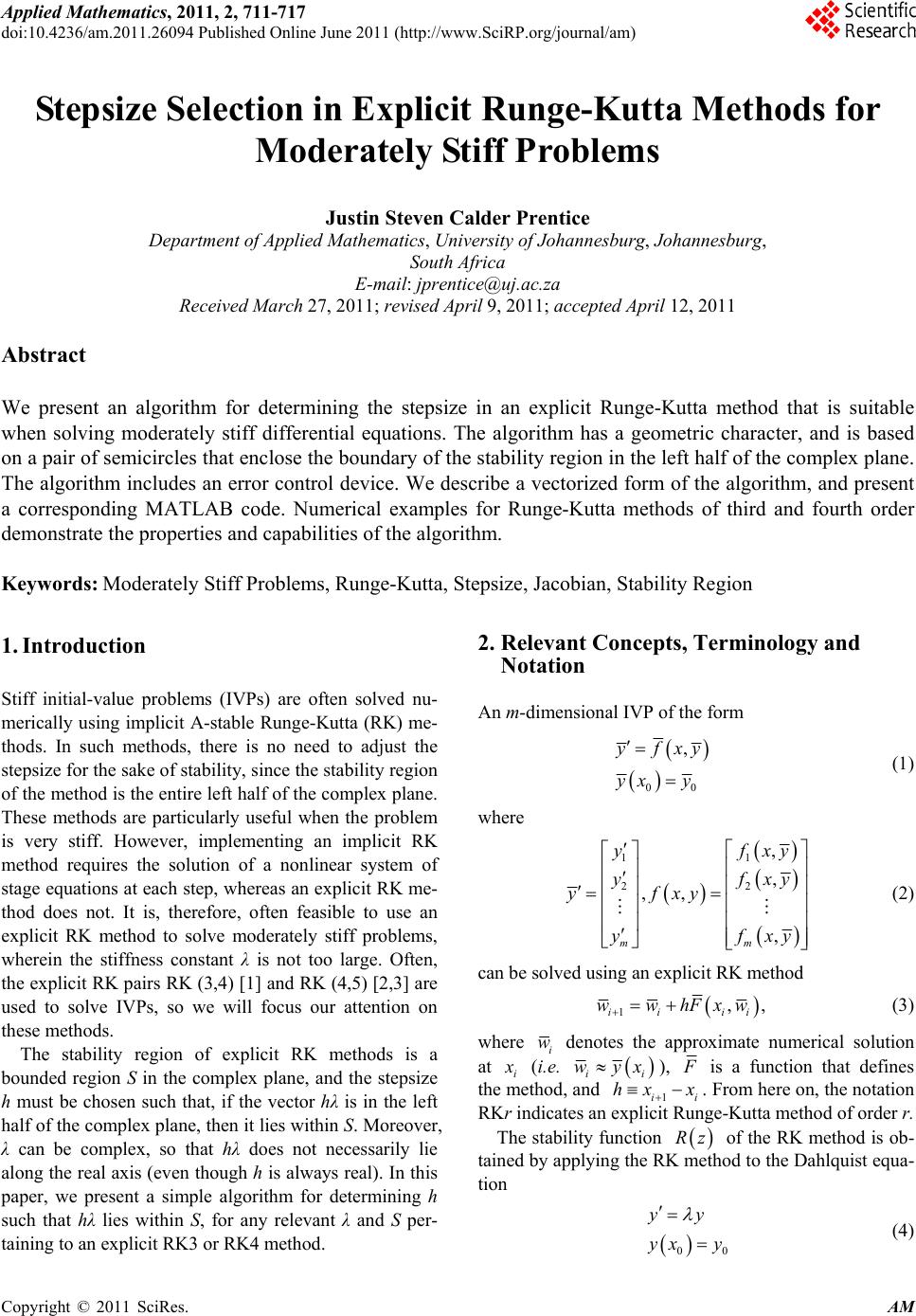 Applied Mathematics, 2011, 2, 711-717 doi:10.4236/am.2011.26094 Published Online June 2011 (http://www.SciRP.org/journal/am) Copyright © 2011 SciRes. AM Stepsize Selection in Explicit Runge-Kutta Methods for Moderately Stiff Problems Justin Steven Calder Prentice Department of Applied Mathematics, University of Johannesburg, Johannesburg, South Africa E-mail: jprentice@uj.ac.za Received March 27, 2011; revised April 9, 2011; accepted April 12, 2011 Abstract We present an algorithm for determining the stepsize in an explicit Runge-Kutta method that is suitable when solving moderately stiff differential equations. The algorithm has a geometric character, and is based on a pair of semicircles that enclose the boundary of the stability region in the left half of the complex plane. The algorithm includes an error control device. We describe a vectorized form of the algorithm, and present a corresponding MATLAB code. Numerical examples for Runge-Kutta methods of third and fourth order demonstrate the properties and capabilities of the algorithm. Keywords: Moderately Stiff Problems, Runge-Kutta, Stepsize, Jacobian, Stability Region 1. Introduction Stiff initial-value problems (IVPs) are often solved nu- merically using implicit A-stable Runge-Kutta (RK) me- thods. In such methods, there is no need to adjust the stepsize for the sake of stability, since the stability region of the method is the entire left half of the complex plane. These methods are particularly useful when the problem is very stiff. However, implementing an implicit RK method requires the solution of a nonlinear system of stage equations at each step, whereas an explicit RK me- thod does not. It is, therefore, often feasible to use an explicit RK method to solve moderately stiff problems, wherein the stiffness constant λ is not too large. Often, the explicit RK pairs RK (3,4) [1] and RK (4,5) [2,3] are used to solve IVPs, so we will focus our attention on these methods. The stability region of explicit RK methods is a bounded region S in the complex plane, and the stepsize h must be chosen such that, if the vector hλ is in the left half of the complex plane, then it lies within S. Moreover, λ can be complex, so that hλ does not necessarily lie along the real axis (even though h is always real). In this paper, we present a simple algorithm for determining h such that hλ lies within S, for any relevant λ and S per- taining to an explicit RK3 or RK4 method. 2. Relevant Concepts, Terminology and Notation An m-dimensional IVP of the form 00 ,yfxy yx y (1) where 11 22 , , ,, , mm y xy y xy yfxy y xy (2) can be solved using an explicit RK method 1, ii ii wwhFxw , (3) where i w denotes the approximate numerical solution at i (i.e. ii wyx), is a function that defines the method, and 1ii hx x . From here on, the notation RKr indicates an explicit Runge-Kutta method of order r. The stability function Rz of the RK method is ob- tained by applying the RK method to the Dahlquist equa- tion 00 yy yx y (4) 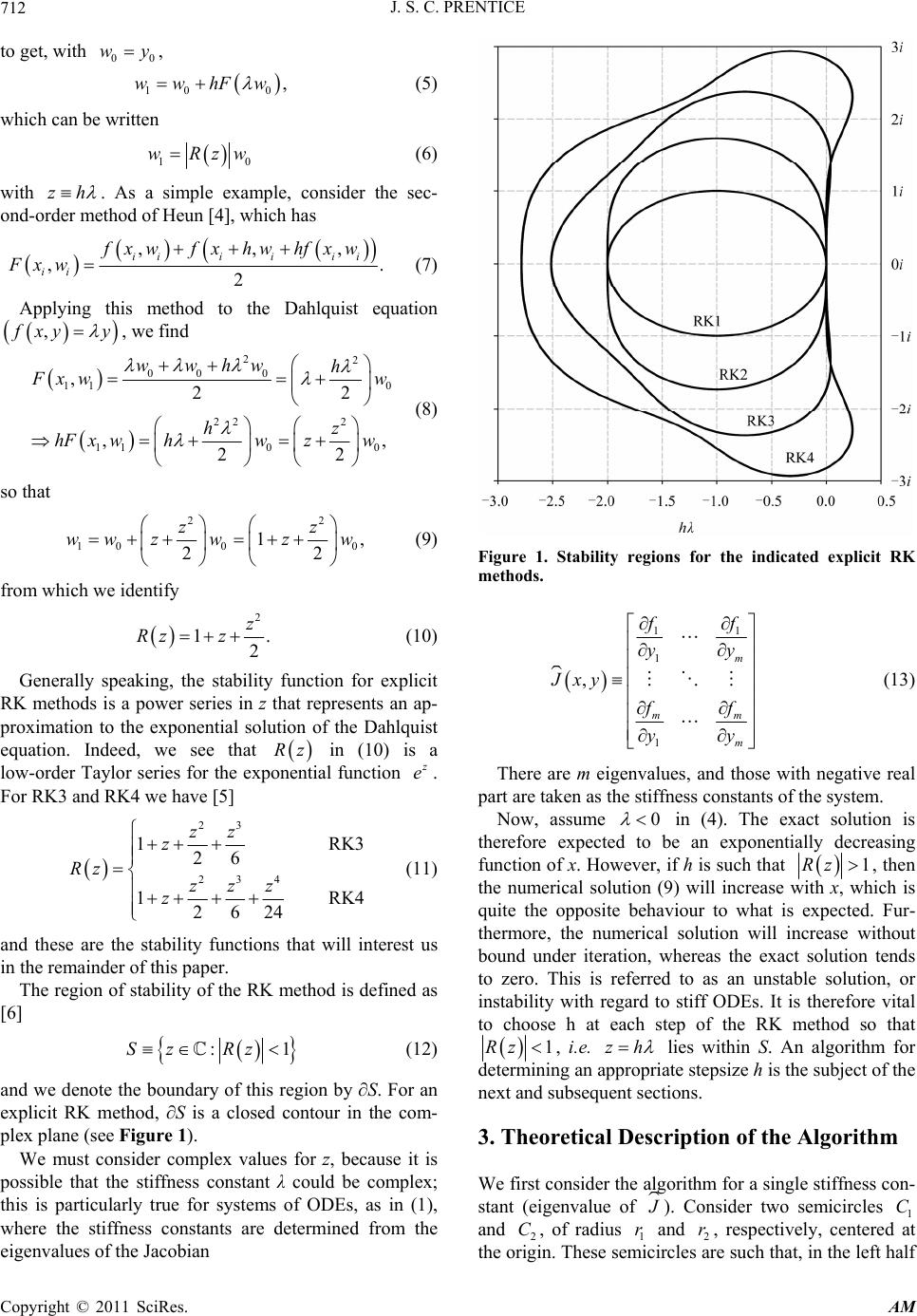 J. S. C. PRENTICE 712 to get, with , 00 wy 10 0 ,wwhFw (5) which can be written 1 wRzw0 (6) with zh . As a simple example, consider the sec- ond-order method of Heun [4], which has ,, ,. 2 iii iii ii fxwfxhw hfxw Fxw , (7) Applying this method to the Dahlquist equation , xy y , we find 22 00 0 11 0 22 2 110 0 ,22 ,, 22 wwhw h xw w hz hF x whwzw (8) so that 22 10 00 1, 22 z ww zwzw z (9) from which we identify 2 1 2 z Rz z . (10) Generally speaking, the stability function for explicit RK methods is a power series in z that represents an ap- proximation to the exponential solution of the Dahlquist equation. Indeed, we see that in (10) is a low-order Taylor series for the exponential function Rz e. For RK3 and RK4 we have [5] 23 234 1 26 1 2624 zz z Rz zzz z RK3 RK4 (11) and these are the stability functions that will interest us in the remainder of this paper. The region of stability of the RK method is defined as [6] :Sz Rz 1 (12) and we denote the boundary of this region by ∂S. For an explicit RK method, ∂S is a closed contour in the com- plex plane (see Figure 1). We must consider complex values for z, because it is possible that the stiffness constant λ could be complex; this is particularly true for systems of ODEs, as in (1), where the stiffness constants are determined from the eigenvalues of the Jacobian Figure 1. Stability regions for the indicated explicit RK methods. 11 1 1 , m mm m f yy Jxy f yy (13) There are m eigenvalues, and those with negative real part are taken as the stiffness constants of the system. Now, assume 0 in (4). The exact solution is therefore expected to be an exponentially decreasing function of x. However, if h is such that 1Rz , then the numerical solution (9) will increase with x, which is quite the opposite behaviour to what is expected. Fur- thermore, the numerical solution will increase without bound under iteration, whereas the exact solution tends to zero. This is referred to as an unstable solution, or instability with regard to stiff ODEs. It is therefore vital to choose h at each step of the RK method so that 1Rz , i.e. zh lies within S. An algorithm for determining an appropriate stepsize h is the subject of the next and subsequent sections. 3. Theoretical Description of the Algorithm We first consider the algorithm for a single stiffness con- stant (eigenvalue of 1 i ). Consider two semicircles 1 and , of radius and , respectively, centered at C half 2 C orig r2 r circles are sthe in. These semuch that, in the left Copyright © 2011 SciRes. AM 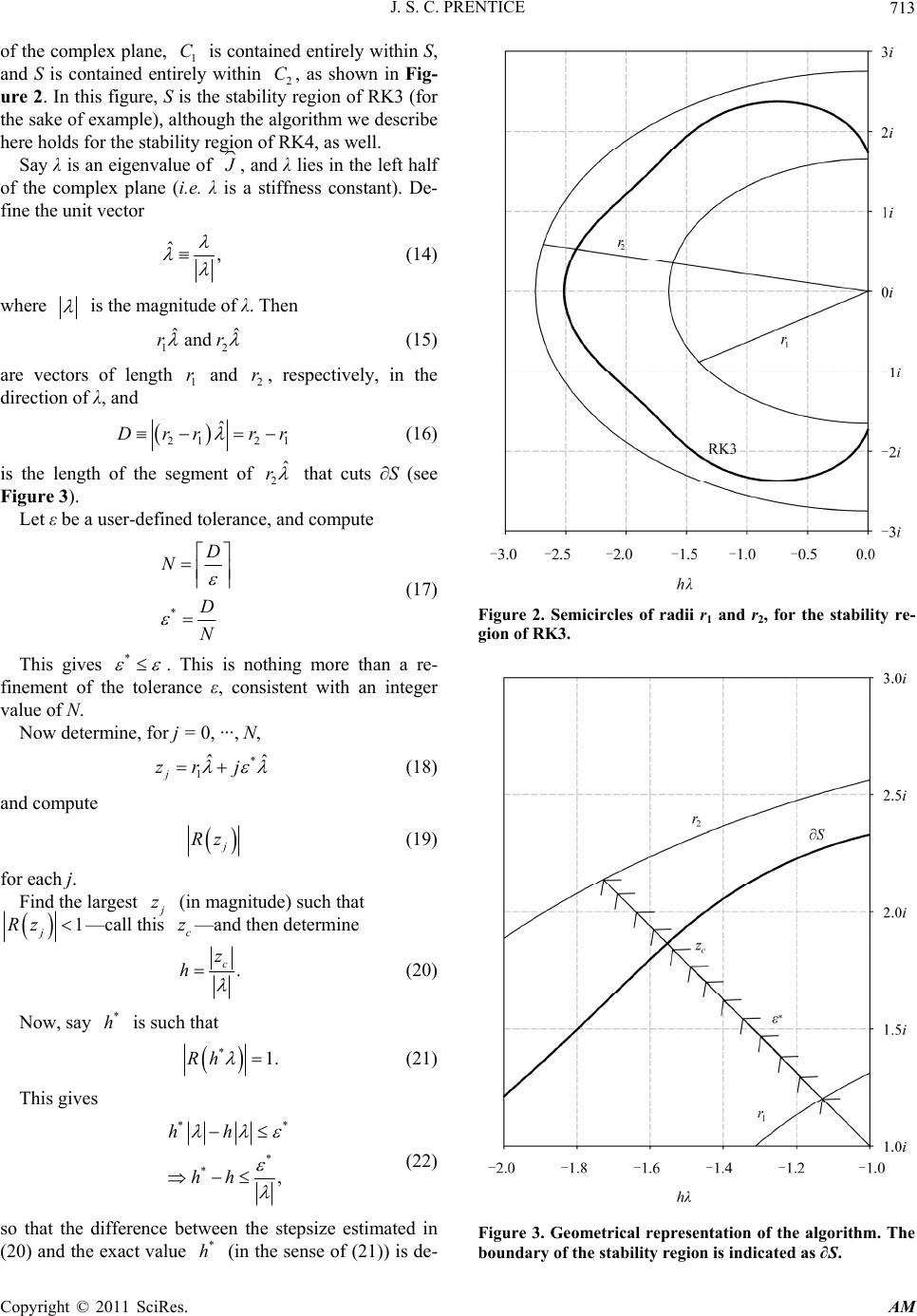 J. S. C. PRENTICE713 of the complex plane, 1 C is contained entirely within S, and S is contained entirely within 2 C, as shown in Fig- ure 2. In this figure, S is the stabiliegion of RK3 (for the sake of example), although the algorithm we describe here holds for the stability region of RK4, as well. Say λ is an eigenvalue of ty r , and λ lies in the left half of the complex plane (i.e. λ a stiffness constant). De- fine the unit vector is ˆ, (14) where is the magnitude of λ. Then 12 ˆˆ and rr (15) are vectors of length and 1 r2 r, respectively, in the direction of λ, and 2121 rr 2ˆ r ˆ r (16) is the length of the segment of Dr that cuts ∂S (see user-defined toleraompute Figure 3). Let ε be ance, and c * D N D N (17) This gives * e toler . This is noting more than a re- fin rmine, for j = 0, ···, N, h ement of thance ε, consistent with an integer value of N. Now dete * ˆˆ zr j 1 j (18) and compute Rz (19) for each j. largest Find the z (in magnitu such that de) 1z—call thc z—and then determine j Ris . c z h (20) Now, say is such that * h * Rh 1. (21) This gives ** * , * hh hh (22) so that the difference between thpsize estimated in (20) and the exact value (in the sense of (21)) is de- e ste * h Figure 2. Semicircles of radii r1 and r2, for the stability re- gion of RK3. Figure 3. Geometrical representation of the algorithm. The boundary of the stability region is indicated as ∂S. Copyright © 2011 SciRes. AM  J. S. C. PRENTICE 714 pendent on * , and . Hence, the smaller we choose ε, the closer the endpoint of hλ is to ∂S, particu- larly for large . Note the following: (22) gives ** hh 1 h hhr (23) and if we demand that the relative difference * hh h must be less than some value δ, then choosing 1 r 1 r (24) ensures that this will be case. In other words, (24) pro- vides a form of error control, since 1 r and δ are known a priori. The algorithm is depicted in Figure 3. In this figure, the curves labelled 1 r and 2 r are the semicircles, and ∂S indicates the boundary of the stability region. The arrow touching the 1 r semicircle indicates 1ˆ r , and the arrow touching the 2 r semicircle indicates 2ˆ r . The arrows between these two represent z for 1, ,1jN. The separation of two adjacentws is * arro , as indicated. The arrow within S and closest to ∂S is It is clear that ∂S cuts 2ˆ r c z, as shown. . The segment ween arrowheads that ∂S cuts is the segment of length D, referred to earlier. For a system of ODEs, in which there is more than one stiffness constant, we bet would apply the above algorithm for each such constant. This would yield a stepsize for each stiffness constant, and we would choose the mini- mum of these stepsizes as h in (3). 4. Implementation of the Algorithm algorithm, H c ere we present a vectorized version of the atering for a system of ODEs which has more than one stiffness constant. The parameters 12 ,rr and ε are input from which N and * are easily mined. Assume that the set of eigenvalues of deter , ii xw yields M distinct stiffness con- stants (note that m). Let denote a row vector containing these ess constants, as in M stiffn 12 , M λ (25) and let ˆ denote the corresponding n vector of unit vec- tors, as i 12 12 12 ˆ . M M M λ 111 222 A NN N (27) 12 12 12 ˆ ˆ times (28) ˆ M M M LN and hence, determine * 1 1NM rA L where (29) 1 M ent-by is the N × M unit matrix, and ⊠ denotes the elem-element product of two matrices, sometimes product (the matrices must have f course). The structure of known as the Hadamard the same dimensions, o is ** 1112 1 ˆˆ M rr * ˆ r ** * 1112 1 ** * 111 21 ˆˆ ˆ 22 2 . ˆˆ M M rr r Z rN rNrN (26) Define the N × M matrices ˆ (30) We then evaluate 1 RK3 26 126 RK4 24 ZZZZZ Z ZZZZZ RZ Z ZZ ZZ where (31) RZ is an N × M matrix, of which the jkth en- try is * 1ˆ. k jk RZRrj (32) We compute RZ , the matrix containing the mag- f eacnitude oh element of RZ , and we find the largest entry less than unity in each column of RZ . The cor- responding elements in are the for each stiffness coare M c nstant. There such values of c z, one for each z stiffness constant k (denotehem ,ck z), and we de- termine t ,ck z k k h (33) Copyright © 2011 SciRes. AM 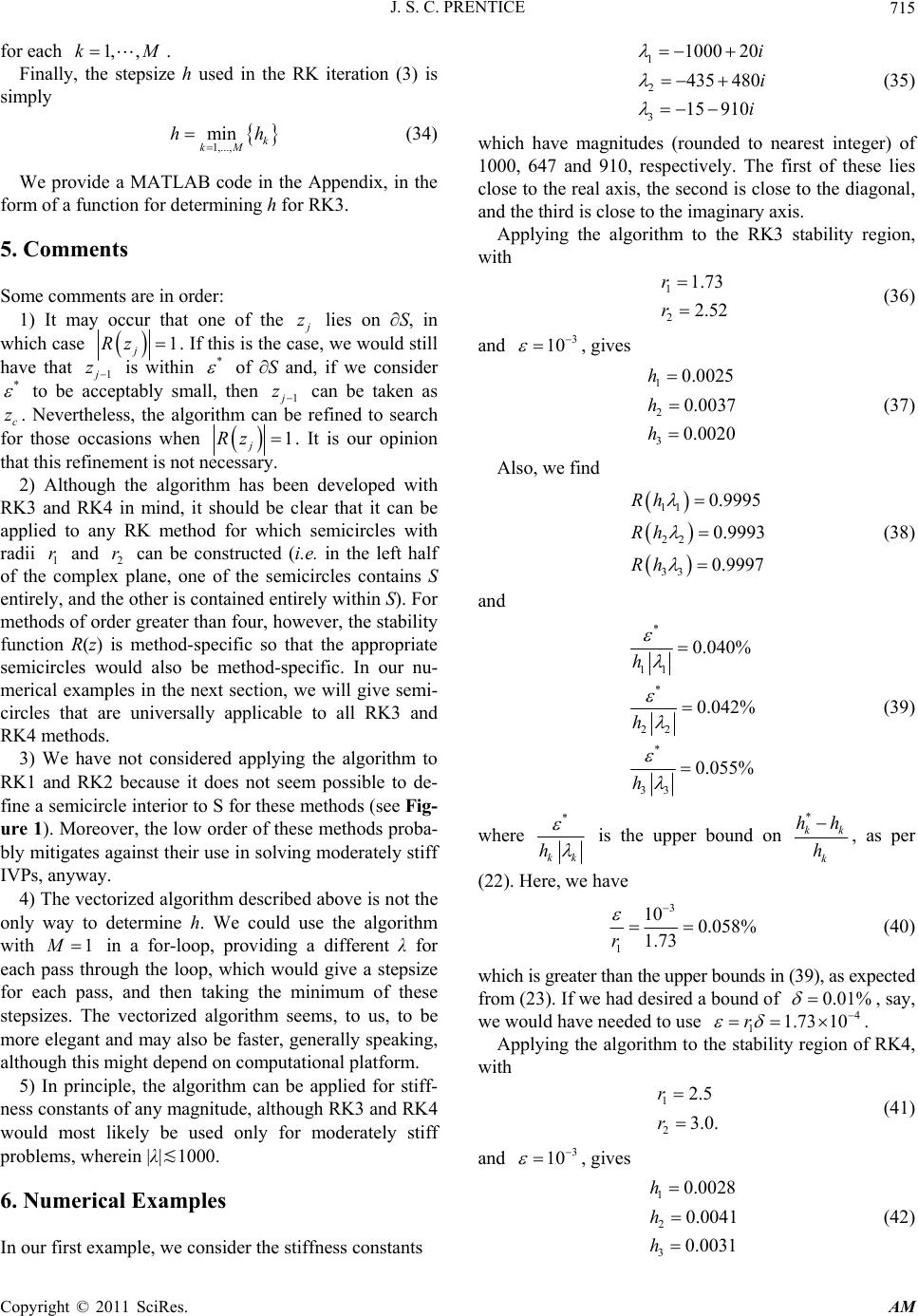 J. S. C. PRENTICE715 (34) We provide a MATLAB code nction for determining h for RK3. 5. Some comments are in order: 1) It may occur that one of the for each 1, ,kM. Finally, the stepsize h used in the RK iteration (3) is simply 1,..., min k kM hh in the Appendix, in the form of a fu Comments z lies on ∂S, in which case 1 j Rz . If this is the case, we would still have that 1 z is within * of ∂S and, if we consider * to be acceptably small, then 1 z can ca be n be taken as gorefined to search when c z. Nevertheless, the al r those occasions rithm fo 1 j Rz . It is our opinion ssar n 4 in mind any ad d of y. that this refinement is not nece 2) Although the algorithm has bee developed with RK3 and RK, it should be clear that it can be applied to RK method for which semicircles with rii 1 r and 2 r can be constructe (i.e. in the left half the complex plane, one of the semicircles contains S entirely, and the other is contained entirely within S). For methods of order greater than four, however, the stability function R(z) is method-specific so that the appropriate semicircles would also be method-specific. In our nu- merical examples in the next section, we will give semi- circles that are universally applicable to all RK3 and RK4 methods. 3) We have not considered applying the algorithm to RK1 and RK2 because it does not seem possible to de- fine a semicircle interior to S for these methods (see Fig- ure 1). Moreover, the low order of these methods proba- bly mitigates against their use in solving moderately stiff IVPs, anyway. 4) The vectorized algorithm described above is not the only way to determine h. We could use the algorithm with 1 in a for-loop, providing a different λ for each pass through the loop, which would give a stepsize for each pass, and then taking the minimum of these stepsizes. The vectorized algorithm seems, to us, to be more elegant and may also be faster, generally speaking, al onstan though this might depend on computational platform. 5) In principle, the algorithm can be applied for stiff- ness cts of any magnitude, although RK3 and RK4 would most likely be used only for moderately stiff problems, wherein |λ|≲1000. 6. Numerical Examples In our first example, we consider the stiffness constants 1 2 3 1000 20 435 480 15 910 i i i (35) which have magnitudes (rounded to nearest integer) of ly. The first of these lies ose to the real axis, the second is close to the diagonal, Applying the algorithm to the RK3 stability region, with (36) 1000, 647 and 910, respective cl and the third is close to the imaginary axis. 1 2 1.73 2.52 r r and 3 10 , gives 1 2 0.0025 0.0037 h h 30.0020h (37) Also, we find 11 22 33 0.9995 0.9993 0.9997 Rh h Rh R (38) and * 11 * 22 * 33 0.040% 0.042% 0.055% h h h (39) is the upper bound on * kk k hh h * kk h where , as per (22). Here, we have 3 1 10 0.058% 1.73 r (40) which is greater than the upper bounds in (39), as expected from (23). If we had desired a bound of 0.01% 73 10 , say, havwe woulde needed to use 4 11.r . e stability region of RK4, Applying the algorithm to th with 1 2 2.5 3.0. r r (41) and 3 10 , gives 1 2 0.0028 0.0 h h 3 041 0.0031 h (42) Copyright © 2011 SciRes. AM 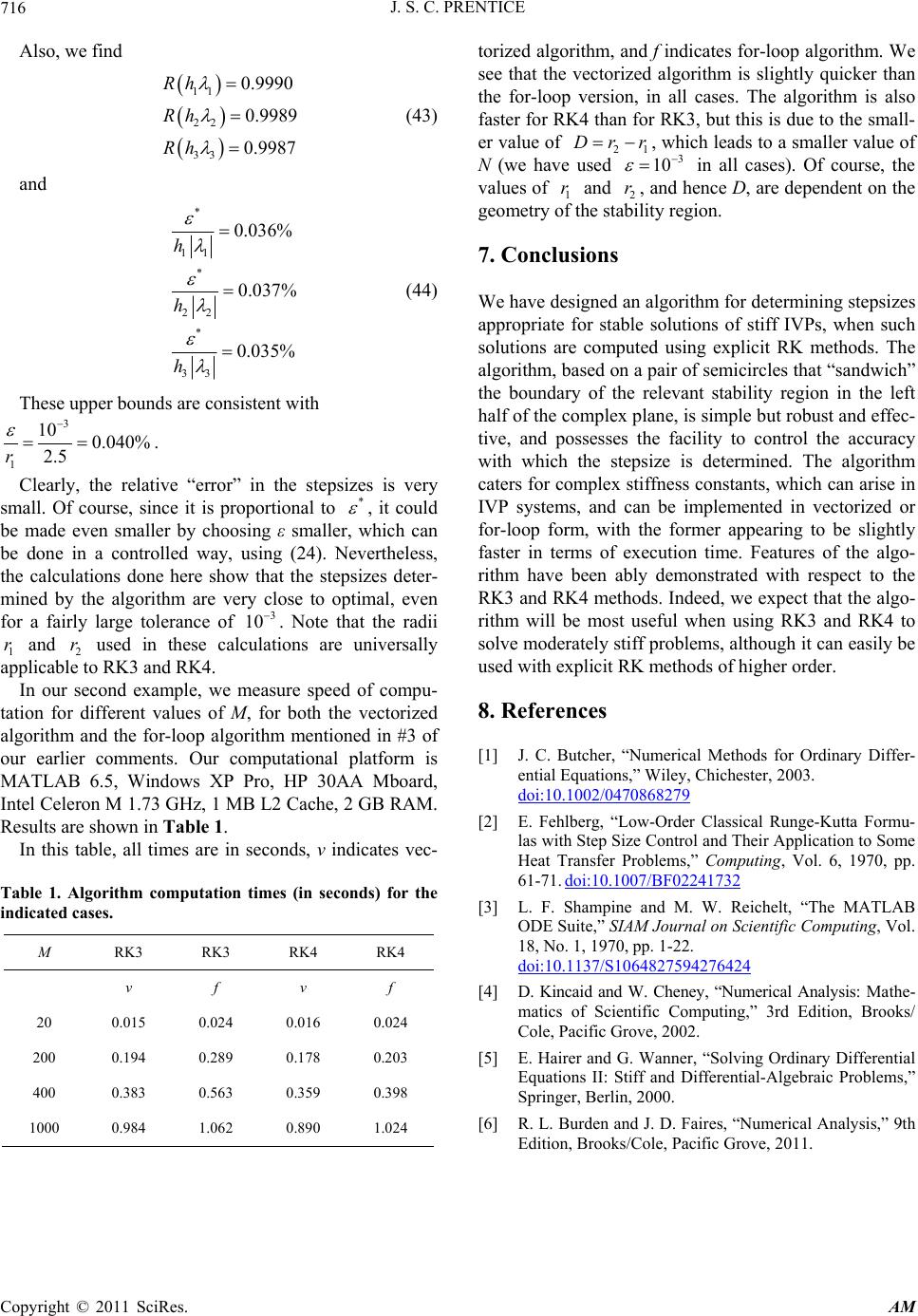 J. S. C. PRENTICE Copyright © 2011 SciRes. AM 716 and torized algoritd f is foralgore see that the vectorized algorithm is slightly quicker than the for-loop v, in aorithmlso fastr RK4for Rt thise to t er value of hm, anndicate-loop ithm. W ersionll cases. The alg is a er fo than K3, bu is duhe small- 21 Also, we find 11 22 33 0.9990 0.9987 Rh Rh Rh 0.9989 (43) Dr r , e u which leads to a aller value of N (v sm we hased 3 in 10all caf cothe n algor icircles that “sandwich” relevant stability region in the left plane, is simple but robust and effec- ses). Ourse, values of 1 r and 2 r, and hence D, are dependent on the geometry of the stability region. 7. Conclusions We have designed aithm for determining stepsizes appropriate for stable solutions of stiff IVPs, when such solutions are computed using explicit RK methods. The gorithm, based on a pair of sem * 11 * 22 * 33 0.036% 0.037% 0.035% h h h (44) upper bounds are consistent with al the boundary of the alf of the complex These h 3 1 10 0.040% 2.5 r . Clearly, the relative “error” in the stepsizes is very small. Of course, since it is proportional to tive, and possesses the facility to control the accuracy with which the stepsize is determined. The algorithm caters for complex stiffness constants, which can arise in IVP systems, and can be implemented in vectorized or for-loop form, with the former appearing to be slightly faster in terms of execution time. Features of the algo- rithm have been ably demonstrated with respect to the RK3 and RK4 methods. Indeed, we expect that the algo- rithm will be most useful when using RK3 and RK4 to solve moderately stiff problems, although it can easily be used with explicit RK methods of higher order. 8. References [1] J. C. Butcher, “Numerical Methods for Ordinary Differ- ential Equations,” Wiley, Chichester, 2003. doi:10.1002/0470868279 2] E. Fehlberg, “Low-Order Classical Runge-Kut * , it could maller, which can be made even smaller by choosing ε s be done in a controlled way, using (24). rtheless, the calculations done here show that the stedeter- mined by the algorithm are very close to al, even for a fairly large tolerance universally applicable to RK3 and RK4. In our second example, we measure speed of compu- ta d seco Neve psizes optim of . Note that the radii and 2 r used in these calculations are 3 10 1 r tion for different values of M, for both the vectorized algorithm and the for-loop algorithm mentione in #3 of our earlier comments. Our computational platform is MATLAB 6.5, Windows XP Pro, HP 30AA Mboard, Intel Celeron M 1.73 GHz, 1 MB L2 Cache, 2 GB RAM. Results are shown in Table 1. In this table, all times are in nds, v indicates vec- Table 1. Algorithm computation times (in seconds) for the ind [ta Formu- ize Control and Their Application to Some Problems,” Computing, Vol. 6, 1970, pp. 61-71. doi:10.1007/BF02241732 las with Step S Heat Transfer icated cases. M RK3 RK3 RK4 RK4 v f v f 20 0.015 0.024 0.016 0.024 200 0.194 0.289 0.178 0.203 400 0.383 0.563 0.359 0.398 1000 0.984 1.062 0.890 1.024 puting, Vol. [3] L. F. Shampine and M. W. Reichelt, “The MATLAB ODE Suite,” SIAM Journal on Scientific Com 18, No. 1, 1970, pp. 1-22. doi:10.1137/S1064827594276424 [4] D. Kincaid and W. Cheney, “Numerical Analysis: Mathe- matics of Scientific Computing,” 3rd Edition, Brooks/ Cole, Pacific Grove, 2002. [5] E. Hairer and G. Wanner, “Solving Ordinary Differential Equations II: Stiff and Differential-Algebraic Problems,” Springer, Berlin, 2000. [6] R. L. Burden and J. D. Faires, “Numerical Analysis,” 9th Edition, Brooks/Cole, Pacific Grove, 2011. 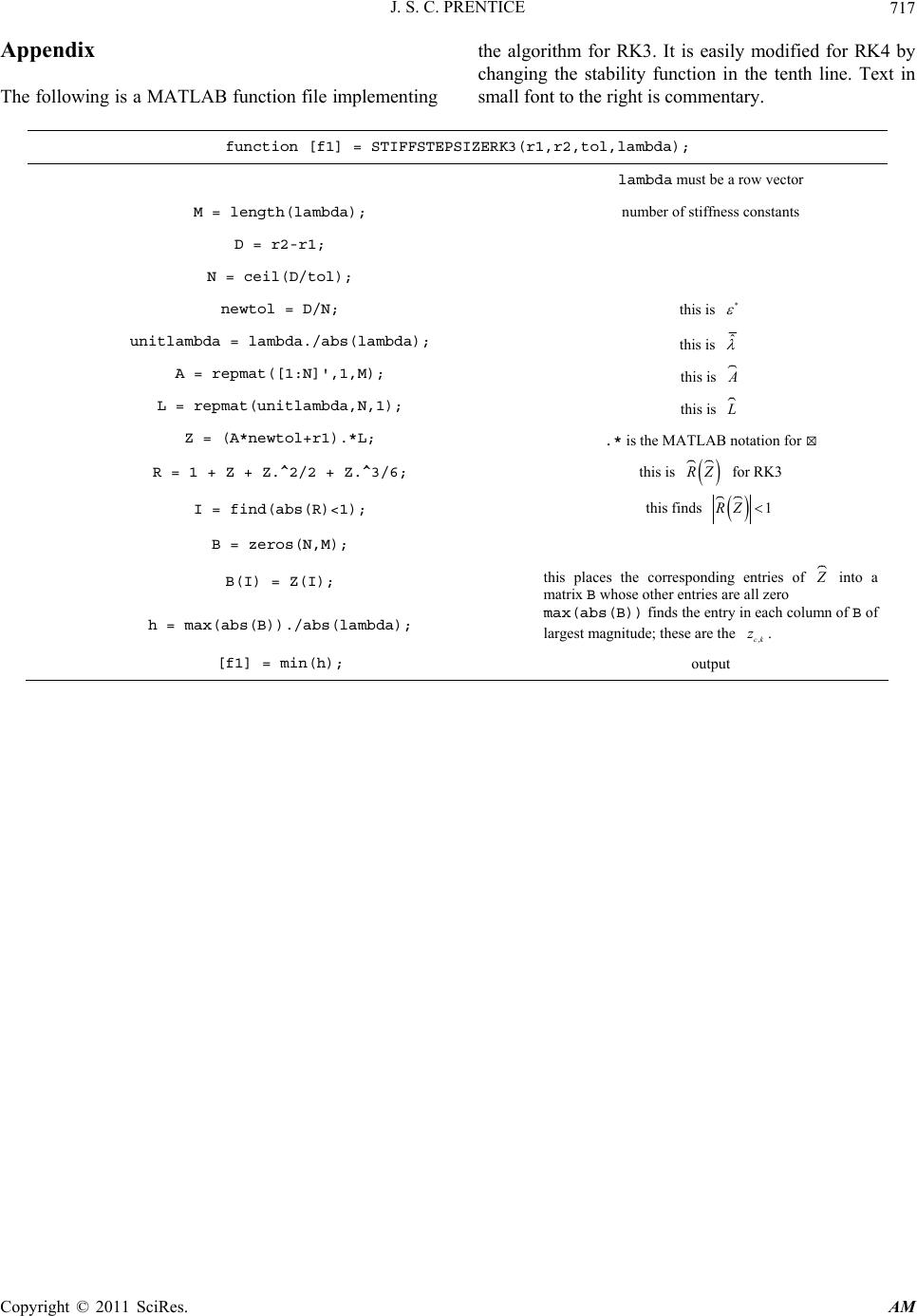 J. S. C. PRENTICE717 The following is a MATLAB function file implementing r RK4 by changing the stability function in the tenth line. Text in small font to the right is commentary. function [f1] = STIFFSTEPSIZERK3(r1,r2,tol,lambda); Appendix the algorithm for RK3. It is easily modified fo lambda must be a row vector M = length(lambda); number of stiffness constants D = r2-r1; N = ceil(D/tol); newtol = D/N; this is * unitlambda = lambda./abs(lambda); this is ˆ A = repmat([1:N]',1,M); this is L = repmat(unitlambda,N,1); this is Z = (A*newtol+r1).*L; .* is the MATLAB notation for ⊠ R = 1 + Z + Z.^2/2 + Z.^3/6; this is Z for RK3 I = find(abs(R)<1); this finds 1RZ B = zeros(N,M); B(I) = Z(I); this places the corresponding entries of into a matrix B whose other entries are all zero h = max(abs(B))./abs(lambda); max(abs(B)) finds the entry in each column of B of largest magnitude; these are the [f1] = min(h); output ,ck z. Copyright © 2011 SciRes. AM
|